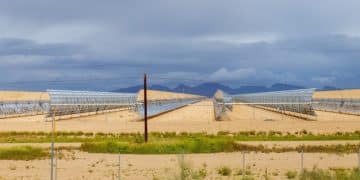Climate Change Report: Is the US on Track for 2030 Goals?

Climate Change Report: Is the US on Track to Meet Its 2030 Emissions Reduction Goals? Examining the current climate change report reveals a mixed bag of progress and challenges, painting a complex picture of whether the United States is on pace to achieve its ambitious emissions reduction targets by 2030.
Are the ambitious climate goals set by the United States for 2030 within reach? A recent Climate Change Report: Is the US on Track to Meet Its 2030 Emissions Reduction Goals? shines a light on the nation’s progress, revealing both successes and significant hurdles.
Understanding the US Climate Change Goals for 2030
The United States has committed to substantial reductions in greenhouse gas emissions by 2030. Understanding the scope and nature of these goals is crucial for assessing current progress and future trajectories.
The Paris Agreement and US Commitments
The Paris Agreement, an international accord on climate change, serves as a foundation for global efforts to curb emissions. The US initially pledged to reduce emissions by 26-28% below 2005 levels by 2025 under the agreement. However, subsequent administrations have adjusted these commitments, setting more ambitious goals.
Biden Administration’s Climate Targets
The Biden administration has set a target of reducing emissions by 50-52% below 2005 levels by 2030. This ambitious goal requires significant policy changes and investments in renewable energy and sustainable infrastructure.
- Transitioning to clean energy sources
- Improving energy efficiency across sectors
- Investing in sustainable transportation
- Promoting carbon sequestration and storage technologies
These policy shifts aim to decarbonize the economy, foster innovation, and create green jobs. Achieving these diverse targets necessitates a coordinated approach across different sectors and levels of government.
In summary, the U.S. climate goals for 2030 are ambitious and require transformative changes across various sectors to achieve significant emissions reductions.
Current Progress: Where Does the US Stand?
Evaluating current progress toward the 2030 targets is essential for identifying successes and areas needing greater attention. Several indicators provide insights into the nation’s current trajectory.

Emissions Trends Over the Past Decade
Analyzing emissions trends over the past decade reveals a complex pattern. While emissions have generally declined, the pace of reduction may not be sufficient to meet the 2030 targets. Economic growth and energy consumption patterns significantly influence these trends.
Furthermore, the impact of specific policies and technological advancements on emissions reduction varies across different sectors, making it challenging to assess the overall progress precisely.
Renewable Energy Adoption and Expansion
The adoption of renewable energy sources, such as solar and wind power, is crucial for decarbonizing the energy sector. The rate of renewable energy expansion has been accelerating, driven by technological advancements and declining costs.
- Increased investment in renewable energy projects
- Advancements in battery storage technology
- Expansion of wind and solar generating capacity
- Government incentives and support for renewables
Despite these positive trends, challenges remain in integrating renewable energy into the grid and ensuring the reliability of supply. Further policy support and infrastructure development are necessary to accelerate the transition to clean energy.
In conclusion, while the US has made some progress in curbing emissions and expanding renewable energy, significant acceleration is required to meet the ambitious 2030 targets. Assessing sector-specific progress provides nuanced insights into the challenges and opportunities ahead.
Key Sectors: Challenges and Opportunities
Different sectors of the economy play varying roles in contributing to emissions and offer diverse opportunities for reduction. Examining each sector’s challenges and opportunities is essential for developing effective strategies.
Energy Sector: Transitioning to Clean Sources
The energy sector is a major contributor to greenhouse gas emissions, primarily through the combustion of fossil fuels. Transitioning to clean energy sources, such as solar, wind, and hydropower, is crucial for decarbonizing this sector.
Strategies for reducing emissions in the energy sector include:
- Phasing out coal-fired power plants
- Investing in renewable energy infrastructure
- Promoting energy efficiency and conservation
- Developing carbon capture and storage technologies
Overcoming regulatory barriers and incentivizing investments in clean energy are essential for driving the transition. Technological advancements and policy support can accelerate progress in reducing emissions from the energy sector.
Transportation Sector: Electrification and Efficiency
The transportation sector is another significant source of emissions, mainly from the combustion of gasoline and diesel in vehicles. Electrification of vehicles and improving fuel efficiency are key strategies for reducing emissions in this sector.
Measures to promote sustainable transportation include:
- Incentivizing the purchase of electric vehicles (EVs)
- Investing in charging infrastructure
- Improving public transportation systems
- Promoting cycling and walking
Addressing consumer concerns about EV range and cost, as well as investing in charging infrastructure, are essential for accelerating the adoption of electric vehicles. Policy support and technological innovations can drive the transition to a cleaner transportation sector.
Ultimately, addressing the challenges and leveraging the opportunities in key sectors such as energy and transportation is crucial for the US to achieve its ambitious emissions reduction goals.
Policy Framework: Federal and State Initiatives
Effective policies at both the federal and state levels are essential for driving emissions reductions and achieving the 2030 targets. Examining existing initiatives and their impacts provides insights into policy effectiveness.
Federal Climate Policies and Regulations
The federal government plays a crucial role in setting national climate policies and regulations. Key federal initiatives include:
- The Inflation Reduction Act
- The Clean Power Plan (subject to legal challenges)
- Investment tax credits for renewable energy
- Regulations on vehicle emissions
Enforcement of these regulations and continued policy support are crucial for driving emissions reductions across various sectors. Coordination between federal agencies and stakeholders can enhance policy effectiveness.
State-Level Climate Action
Many states have implemented their own climate policies and regulations, often exceeding federal requirements. Examples of state-level initiatives include:
- Renewable portfolio standards (RPS)
- Carbon pricing mechanisms (e.g., cap-and-trade)
- Energy efficiency standards for buildings and appliances
- Investments in public transportation
State-level actions can serve as models for national policies and can drive innovation in clean energy and emissions reduction strategies. Collaboration between states and the federal government can enhance the overall effectiveness of climate policies.
In summary, a coordinated policy framework involving federal and state initiatives is crucial for driving emissions reductions and achieving the 2030 targets. Effective policies should incentivize innovation, promote clean energy adoption, and address emissions from key sectors.

Economic Impacts of Climate Action
Addressing climate change has significant economic implications, both in terms of costs and benefits. Assessing the economic impacts of climate action helps inform policy decisions and investment strategies.
Costs of Transitioning to a Low-Carbon Economy
Transitioning to a low-carbon economy requires substantial investments in renewable energy, infrastructure, and technology. The costs of this transition can include:
- Retiring fossil fuel assets
- Investing in renewable energy infrastructure
- Upgrading the grid to accommodate renewable energy
- Developing carbon capture and storage technologies
However, these costs can be offset by long-term benefits, such as reduced energy costs, improved air quality, and job creation in the clean energy sector. Careful planning and policy support can minimize the economic costs of the transition.
Economic Benefits of Climate Action
Taking action to address climate change can generate significant economic benefits, including:
- Job creation in the renewable energy sector
- Reduced healthcare costs due to improved air quality
- Increased energy security through domestic renewable energy production
- Innovation and competitiveness in clean technologies
Quantifying these economic benefits is essential for justifying climate action and attracting investments in clean energy and sustainable development. A comprehensive assessment of economic impacts should consider both short-term costs and long-term benefits.
In conclusion, addressing climate change has significant economic implications, with both costs and benefits. A well-planned transition to a low-carbon economy can generate economic opportunities, improve public health, and enhance energy security.
Future Outlook: Challenges and Opportunities Ahead
Looking ahead, the US faces both challenges and opportunities in meeting its 2030 emissions reduction goals. Addressing these challenges and leveraging the opportunities requires concerted efforts across various sectors and levels of government.
Technological Advancements and Innovation
Technological advancements play a crucial role in driving emissions reductions and achieving the 2030 targets. Key areas of innovation include:
- Advanced battery storage technologies
- Carbon capture and storage (CCS)
- Green hydrogen production
- Smart grid technologies
Continued investment in research and development is essential for accelerating these technological advancements. Collaboration between government, industry, and academia can foster innovation and drive the development of new clean energy solutions.
Policy and Regulatory Certainty
Policy and regulatory certainty are crucial for attracting investments in clean energy and driving emissions reductions. Clear and consistent policies can provide businesses and investors with the confidence they need to commit to long-term projects.
Examples of policies that promote certainty include:
- Long-term extensions of renewable energy tax credits
- Clear and consistent regulations on emissions
- Support for clean energy infrastructure development
- Incentives for carbon capture and storage
Addressing policy uncertainties and ensuring regulatory stability can enhance the effectiveness of climate action and accelerate progress toward the 2030 targets.
Finally, the future success of the US in meeting its climate goals depends on continuous efforts to address challenges, leverage opportunities, and foster innovation through collaboration between stakeholders at every level.
| Key Point | Brief Description |
|---|---|
| 🎯 2030 Emissions Target | US aims for a 50-52% reduction below 2005 levels. |
| ☀️ Renewable Energy Growth | Significant expansion in solar and wind power adoption. |
| ⚡ Transportation Electrification | Push for electric vehicles and infrastructure development. |
| 🏛️ Policy Support | Federal and state initiatives driving climate action. |
Frequently Asked Questions
▼
The US aims to reduce greenhouse gas emissions by 50-52% below 2005 levels by 2030, a commitment under the Paris Agreement.
▼
Key sectors include energy (transitioning to renewables), transportation (electrification), and industry (efficiency improvements).
▼
Federal policies set national standards, while state policies often drive more aggressive action and innovation in clean energy.
▼
Benefits include job creation in clean energy, reduced healthcare costs from cleaner air, and increased energy security.
▼
Challenges include policy uncertainty, technological hurdles, and ensuring equitable transitions across all sectors.
Conclusion
In conclusion, the United States faces both significant challenges and promising opportunities in its pursuit of the 2030 emissions reduction goals. While progress has been made in renewable energy adoption and policy implementation, accelerating efforts across all sectors and maintaining a consistent policy framework will be crucial to staying on track and achieving a sustainable future.





